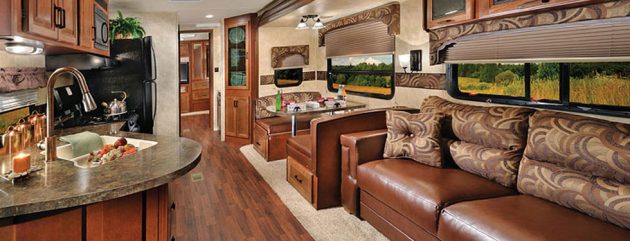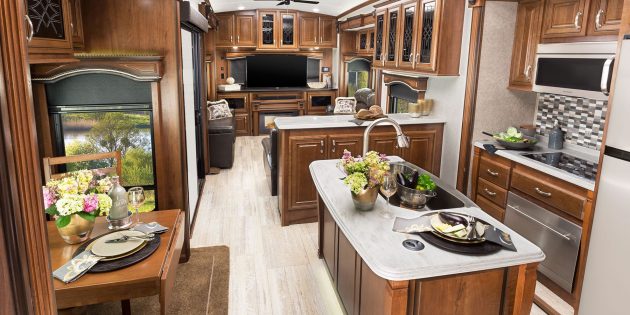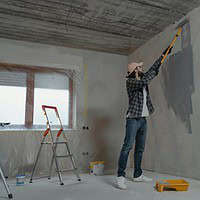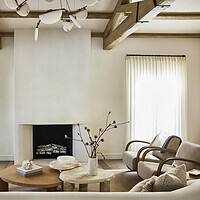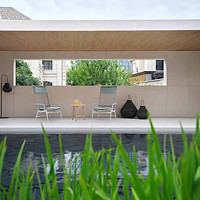Most RVs have the same shape, a rounded rectangle on wheels that maximizes internal space while attempting to reduce drag. A minority of RVs are designed to minimize drag, whether it is a teardrop shape or a pill shaped trailer. These RVs are easier to tow, but they have limited use of internal space due to the curves. These challenges are pushing architects to find new solutions such as putting in metal RV covers.
How does an architect tackle a new shape for an RV or camper trailer?
The Swoop
This is an entirely decorative feature. The long swooping lines on the side of the RV are so common that it is hard to find one without this decorative element. It started to be popular in the eighties. One theory is that it was intended to symbolize the freedom the RV represented.
Another was that it was a cheap way to decorate RVs without having to paint the entire thing. There are variations on the brown, grey, silver or black swoop like an American flag or outline of a mountain landscape.
If you want to upgrade the appearance of your RV, it is easy to arrange for full landscapes to be printed on laminates and applied to the RV. It uses the same technology as car wraps. Or you could stand out from the crowd and opt for a single color paint job on the RV that isn’t white.
You can certainly ask an architect or RV maker to put different colors on the RV, whether you want a jet black, grey or even purple RV. However, the customization options for RVs go much further than this. In this case, online RV bloggers are so friendly to help for real RV architecture. You can contact https://rvside.com/ who offers free helps for any troubleshoots about full time RVing.
The Non-Standard Shell
RVs are typically built into the same couple of “shells”, the blocky boxes that fit over the engines. Customization efforts then focus on giving you the appliances, seating areas and amenities you want. This is cheaper for the manufacturer and the end user.
One way to get a different shape for your RV is to use a different shell. And this can go much further than the shelf-like extension on travel trailers that give you space to sleep two over the truck bed or trailer hitch.
Classic examples can be found in converted school buses. They’re using an existing engine and vehicle exterior but have a very different internal space to work with. For example, school buses are 20 to 27 feet long. This is long enough to have comfortable living space for an RV without having a difficult to manage turn radius.
More importantly, the steel ribbed arches that span the bus leave the interior open. A school bus thus allows you to have the space for a long workbench, shelves or a real bath tub. The vehicle itself is wide enough for a bed in the back.
The bus provides many more windows than the average RV, while the high arched ceilings make it easier to walk around in than many camper vans.
The Camper Van
The camper van is by definition a camper fit into the back of a van. The simplest version is a standard van with a mattress thrown in the back. Camper vans tend to have more amenities like a small stove top, organized storage, and a fold-away bed. It is difficult but not impossible to find a camper van that has a toilet or shower, since the van is so small.
The average architect has to prioritize what to put in the van and find ways to fit it in, but many would-be campers would go with this type of camper if possible.
The smaller vehicle’s size has that many advantages. For example, you can park almost anywhere. Its handling is similar to a van or large SUV, and that eliminates the risky learning curve for drivers.
A camper van allows you to stealth camp, sleeping in the van parked on the street in places where RVs are not allowed. And you won’t get in trouble for parking a camper van in a driveway, because it isn’t the large RV that some home owners’ associations ban.
The smaller vehicle also has better fuel efficiency, so you won’t spend as much money traveling cross-country. And if you want to do something different, you don’t have to convert a passenger van. You could convert a cargo van, minivan, shuttle bus or large SUV instead.
One benefit of this choice is that the camper van can be worked on at any repair shop. This is incredibly helpful when you’re dealing with engine problems or a broken axle. And you won’t have trouble finding a tow truck to take it to the shop, either.
That’s why many people buy a van and then ask a designer what they can do with it.
The Endless Options in the Teardrop Trailer
There are tear-dropped shaped trailers that can be modified to almost any final form through changes in the shape of the pop-up tents and extensions. You can see variations of this in the hybrid camper-trailer. The camper trailer has at least one bedroom, bathroom and kitchen area.
However, you get more living space and sleeping spots when you extend the tents. And these trailers can be endlessly modified to maximize internal space, such as when you put the grill on the back so you have more space to live inside.
Talk to an architect to find out if the vehicle you’re interested in can be converted to an RV/camper with the amenities you want.
The Non-Standard Interior
You may have already worked in a non-standard interior of an RV or converted bus. School buses turned into mobile blood banks often travel the streets. Mobile doctor’s offices and veterinary clinics are become common.
Camper vans sometimes become mobile food trucks, educational kiosks, training centers or retail outlets. Customized RVs may combine work and residence, such as when you buy a customized horse trailer that includes living space for the owner. Or you might order an RV that has a dedicated home office corner instead of a generic seating area.
Think about storage areas designed to hold and protect a server or computer along with hidden wiring suitable for it. This is true whether it is a travel trailer or a class C motor home. On the other hand, some travel trailers are converted into mobile offices or command centers. The only question for the architect with this type of custom RV design is what you need the vehicle to be.
An increasingly common choice is the toy-hauler. These RVs have a trailer on back that lets you pull golf carts, ATVs, bikes and other toys with you. Depending on the model, it could become an extension of the living space. That’s especially true if you add an awning.
More Custom RV And Tiny House Designs
The great thing about RVs is that it’s like a tiny home that you can bring around with you wherever you go. Hence, it has become the rising interest of many homeowners to have an RV.
In closing, it’s fitting to discuss some tips as to how you can design your RV to turn it into a cozy tiny house.
- The first thing that you need to keep in mind is that there’s no set size of a house. Your house should be able to accommodate how many family members you have. This being said, you shouldn’t feel too cramped when you’re inside your RV.
Fortunately, there are many different sizes of RV you can choose from. So, when it comes to designing your custom RV, you’ve got more leeway with the design, without having to worry about the size.
- As you speak with architects or professionals in brainstorming your RV or tiny house designs, it should also fit the budget you’ve set for the custom RV design. With the right team, you won’t have to break a hole in your pocket just to have the RV design done. The key is for you to have that striking balance, which means that you also have to cooperate with the design team. The more that you’re hands-on with the entire plan, the cheaper and faster the design process will be.
- Create a lot of fold-down options in your RV designs. This refers to the furniture that you’re going to incorporate in your custom design. Remember that the key here is for you to make the most space possible. So, you wouldn’t want to bulk up with too much unnecessary furniture.
Fold-down options are a great way to maximize some space, especially when you need to create multiple areas in a very small area. In doing so, moving around the RV would still be very comfortable.
Conclusion
You don’t have to choose between cookie cutter rectangular boxes with white paint and colorful flourishes if you don’t want a silver or beige teardrop trailer. You can search for or order a customized RV or camper trailer that suits your wants and needs.

